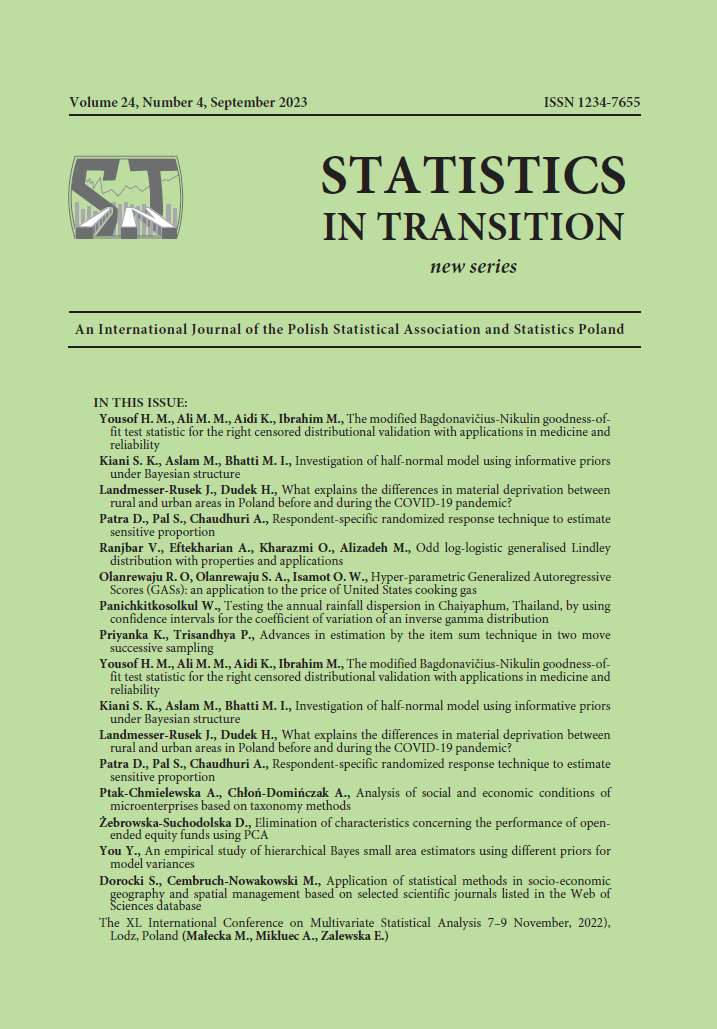ARTICLE
ABSTRACT
We examined the relationships between the compositional changes in demographic and socioeconomic factors and the changes in the prevalence of material deprivation in rural and urban areas in Poland. Using the European Union Statistics on Income and Living Conditions (EU-SILC) data for 2019–2020, we applied the Fairlie decomposition approach for a logit model. We found that the important characteristics affecting a gap in material deprivation between rural and urban areas are: equivalized income, the level of education, the type of household, and the presence of disabled or unemployed people in the household. A non-significant effect of the pandemic on the material deprivation gap between rural and urban areas was observed.
KEYWORDS
rural-urban differences, COVID-19, logit model, Fairlie decomposition, EU-SILC
REFERENCES
Barcena-Martin, E., Lacomba, B., Moro-Egido, A.I., Perez-Moreno, S., (2014). Country Differences in Material Deprivation in Europe. Review of Income and Wealth, Vol. 60(4), pp. 802–820.
Beduk, S., (2018). Understanding Material Deprivation for 25 EU Countries: Risk and Level Perspectives, and Distinctiveness of Zeros. European Sociological Review, Vol. 34(2), pp. 121–137.
Bernard, J., (2019). Where Have All the Rural Poor Gone? Explaining the Rural–Urban Poverty Gap in European Countries. Sociologia Ruralis, Vol. 59 (3), pp. 369-392.
Blinder, A. S., (1973). Wage Discrimination: Reduced Form and Structural Variables. Journal of Human Resources, Vol. 8, pp. 436-455.
Boto-Garcia, D., Bucciol, A., Manfre, M., (2022). The role of financial socialization and self-control on saving habits. Journal of Behavioral and Experimental Economics, Vol. 100, 101903.
Broussard, N. H., (2019). What Explains Gender Differences in Food Insecurity. Food Policy, Vol. 83, pp. 180–194.
Dudek, H., (2019). Country-level Drivers of Severe Material Deprivation Rates in the EU. Ekonomický časopis, Vol. 67(1), pp. 33–51.
Dudek, H., Szczesny, W., (2021a). Multidimensional material deprivation in Poland: a focus on changes in 2015–2017. Quality & Quantity, Vol. 55, pp. 741–763.
Dudek, H., Szczesny, W., (2021b). Dudek, H., Szczesny, W., (2021). Multi-Dimensional Material Deprivation in the Visegrad Group: Zero-Inflated Beta Regression Modelling. In: Betti, G., Lemmi, A. (eds.), Analysis of Socio-Economic Conditions: Insights from a Fuzzy Multidimensional Approach. London and New York: Routledge, pp. 151–165.
Eurostat, (2022). https://ec.europa.eu/eurostat/data/database. Accessed March 17, 2022.
Fairlie, R. W., (2005). An Extension of the Blinder-Oaxaca Decomposition Technique to Logit and Probit Models. Journal of Economic and Social Measurement, Vol. 30(4), pp. 305–316.
Fairlie, R. W., Robb, A. M., (2007). Why are Black-Owned Businesses Less Successful than White-Owned Businesses: The Role of Families, Inheritances, and Business Human Capital. Journal of Labor Economics, Vol. 25(2), pp. 289–323.
Fairlie, R. W., (2017). Addressing Path Dependence and Incorporating Sample Weights in the Nonlinear Blinder-Oaxaca Decomposition Technique for Logit, Probit and Other Nonlinear Models. SIEPR Discussion Paper, No. 17–013. https://siepr.stanford.edu/sites/default/files/publications/17-013.pdf. Accessed February 7, 2022.
Fusco, A., Guio, A.-C., Marlier, E., (2013). Building a Material Deprivation Index in a Multinational Context: Lessons from the EU Experience. In: Berenger, V., Bresson, F. (eds.) Poverty and Social Exclusion around the Mediterranean Sea, pp. 43–71. Springer, New York.
Głowicka-Wołoszyn, R., (2019). Multi-Dimensional Assessment of Housing Conditions of the Population in Rural and Urban Areas of the Wielkopolskie Voivodeship. Annals of the Polish Association of Agricultural and Agribusiness Economists, T. 21(2), pp. 79–87,
Guio, A.-C., Marlier, E., Gordon, D., Fahmy, E, Nandy, S., Pomati, M., (2016). Improving the Measurement of Material Deprivation at the European Union Level. Journal of European Social Policy, Vol. 26(3), pp. 219–333.
Guio, A.-C., (2018). Multidimensional Poverty and Material Deprivation: Empirical Findings. In: D’Ambrosio, C. (eds.) Handbook of Research on Economic and Social Well-Being, pp. 171–192. Edward Elgar Publishing, Cheltenham.
Jann, B., (2006). Fairlie: Stata Module to Generate Nonlinear Decomposition of Binary Outcome Differentials. Available from http://ideas.repec.org/c/boc/bocode/s456727.html. Accessed March 21, 2022.
Kalinowski, S., (2022). Ubostwo i wykluczenie na wsi. In: J. Wilkin, A. Hałasiewicz (eds.), Polska Wieś 2022. Raport o stanie wsi, Wyd. FDPA, WN Scholar: Warszawa, pp. 153–169.
Landmesser, J., (2009). The Survey of Economic Activity of People in Rural Areas – the Analysis Using the Econometric Hazard Models. Acta Universitatis Lodziensis, Folia Oeconomica, No. 228, pp. 385–392.
Landmesser, J. M., Karpio, K., Łukasiewicz, P., (2015). Decomposition of Differences Between Personal Incomes Distributions in Poland. Quantitative Methods in Economics, Vol. XVI(2), pp. 43–52.
Landmesser, J. M., (2017). Differences in Income Distributions for Men and Women in Poland – an Analysis Using Decomposition Techniques. Acta Scientiarum Polonorum. Oeconomia, Vol. 16(4), pp. 103–112.
Łuczak, A., Kalinowski, S., (2020). Assessing the Level of the Material Deprivation of European Union Countries. PLoSONE, Vol. 15(9), e0238376.
Oaxaca, R., (1973). Male-Female Wage Differentials in Urban Labor Markets. International Economic Review, Vol. 14, pp. 693–709.
Poverty in Poland in 2019 and 2020, (2021). Statistics Poland, Warsaw.
Rahimi, E., Hashemi Nazari, S. S., (2021). A Detailed Explanation and Graphical Representation of the Blinder-Oaxaca Decomposition Method with its Application in Health Inequalities. Emerging Themes in Epidemiology, Vol. 18, 12.
Słoczyński, T., (2012). Wokoł międzynarodowego zrożnicowania międzypłciowej luki płacowej. International Journal of Management and Economics, Vol. 34, pp. 169–185.
Sompolska-Rzechula, A., Kurdys-Kujawska, A., (2020). Quality of Life of Rural and Urban Population in Poland: Evaluation and Comparison. European Research Studies Journal, Vol. 23(3), pp. 645–656.
Statistics Poland, (2022). Dochody i warunki życia ludności Polski – raport z badania EU-SILC 2020. Głowny Urząd Statystyczny, Warszawa. Available from https://stat.gov.pl/obszary-tematyczne/warunki-zycia/dochody-wydatki-iwarunki- zycia-ludnosci/dochody-i-warunki-zycia-ludnosci-polski-raport-zbadania- eu-silc-2020,6,14.html. Accessed April 2, 2022.
Swain, N., (2016). Eastern European Rurality in a Neo-Liberal. European Union World. Sociologia Ruralis, Vol. 56 (4) pp. 574–596.
Śliwicki, D., Ryczkowski, M., (2014). Gender Pay Gap in the Micro Level – Case of Poland. Quantitative Methods in Economics, Vol. XV(1), pp. 159–173.
Šoltes, E., Ulman, P., (2015). Material deprivation in Poland and Slovakia – a comparative analysis. Zeszyty Naukowe Uniwersytetu Ekonomicznego w Krakowie, Vol. 947(11), pp. 19–36.
Wołoszyn, A., Wysocki, F., (2020). Income Inequality of Polish Rural and Urban Households in 2010–2017. Annals of Polish Association of Agricultural Economists and Agribusiness, Vol. 22(1), pp. 360–368.
Zajkowska, O., (2013). Gender Pay Gap in Poland – Blinder-Oaxaca Decomposition. Quantitative Methods in Economics, Vol. XIV(2), pp. 272–278.
